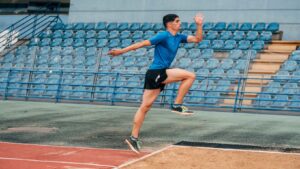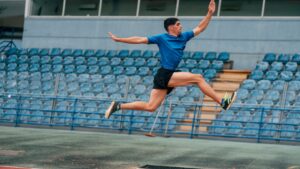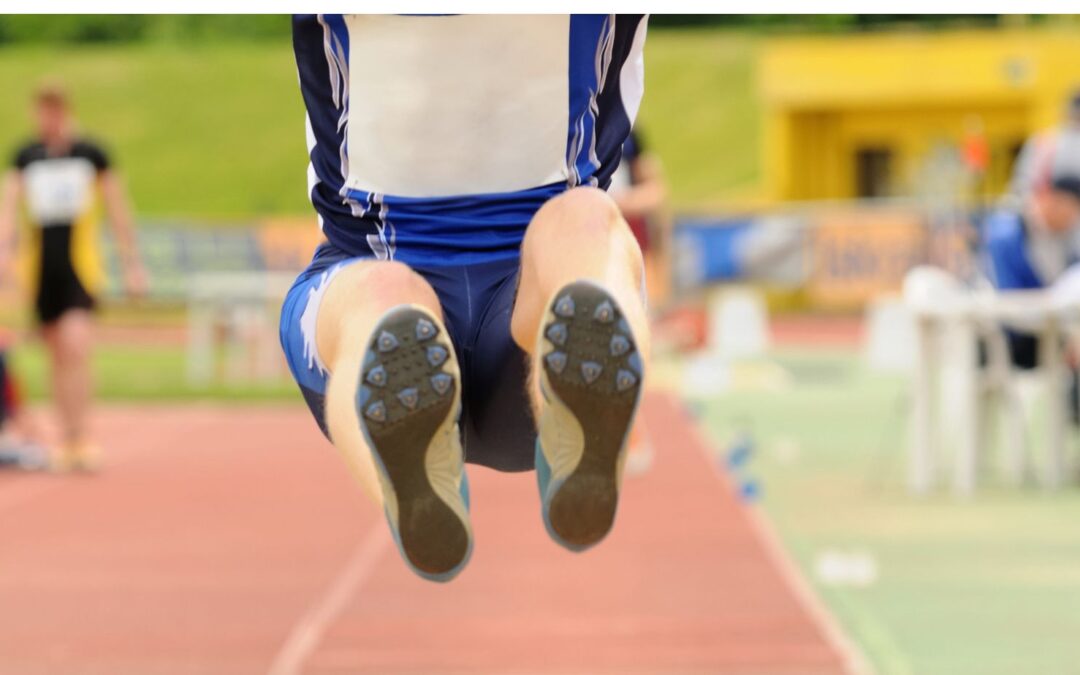Long jump is an athletic sport that’s a lot more complex than just running and jumping. It requires precision, technique, and a whole lot of practice. Mistakes are common, but they can be avoided with the right knowledge and preparation.
In my years as an athlete and coach, I’ve seen countless long jumpers make avoidable errors.  These mistakes often lead to suboptimal performances or even injuries. That’s why it’s crucial for every jumper to know what pitfalls to steer clear from.
These mistakes often lead to suboptimal performances or even injuries. That’s why it’s crucial for every jumper to know what pitfalls to steer clear from.
Today, I’ll be sharing hal-hal yang perlu dihindari dalam lompat jauh adalah some of the most common blunders long jumpers should avoid at all costs. From poor training habits to on-the-day errors, understanding these could mean the difference between soaring through the air or falling flat on your face. So whether you’re a seasoned pro or just starting out in this thrilling sport, stick around because this advice might just save your next leap!
Hal-Hal Yang Perlu Dihindari Dalam Lompat Jauh Adalah
We’ve all seen it happen. Even the most seasoned long jumpers can fall victim to an incorrect takeoff technique. It’s a common mistake, but one that can drastically hinder your performance in this pivotal moment of the leap.
Getting your takeoff wrong is like fumbling the start of a hal-hal yang perlu dihindari dalam lompat jauh adalah 100-meter sprint. It hampers your momentum and throws off your whole rhythm. Typically, when I talk about incorrect takeoff techniques, I’m referring to three main errors:
- Incorrect Foot Placement: Your foot should hit the board squarely at takeoff. If it’s too far forward or back, you’re going to lose valuable distance on your jump.
- Wrong Angle of Attack: Aim for an angle between 20–22 degrees at takeoff. Any higher and you’ll sacrifice distance for height; any lower and you won’t get enough lift.
- Poor Body Positioning: At the point of take-off, your body should be upright with a slight lean forward – this helps optimize both speed and lift.
Don’t underestimate these mistakes’ impact; they could cost you crucial inches, even feet in some cases! For instance, let’s look at some numbers from my own experience as a trainer:
| Mistake | Estimated Loss in Distance |
|---|---|
| Incorrect Foot Placement | Up to 1 foot |
| Wrong Angle of Attack | Up to 2 feet |
| Poor Body Positioning | Up to 1.5 feet |
 These figures demonstrate just how much these technical errors can affect performance!
These figures demonstrate just how much these technical errors can affect performance!
So there we have it – an exploration into the pitfalls of improper hal-hal yang perlu dihindari dalam lompat jauh adalah long jump technique in action! By correcting these common missteps, you’ll make significant strides towards perfecting your long jump form – trust me on this one! Remember: every inch counts when it comes down to those final results!
Overstriding
Just when you think you’ve mastered the art of long jump, overstriding can sneak up and hold you back. It’s a common mistake made by many athletes, but I’m here to help you avoid it.
First off, let’s clarify what overstriding is. Simply put, it’s when an athlete extends their stride too much during the approach phase of the jump. This causes your foot to land way ahead of your center of gravity which in turn disrupts your balance and momentum.
Now, why is this a problem? Well, overstriding not only hampers your speed but also puts unnecessary stress on your lower body joints. Here are some consequences:
- Reduced Speed: When you’re landing with your foot far out in front, it acts like a brake slowing down each step.
- Increased Injury Risk: Overstriding increases the impact forces on joints such as knees and hips leading to potential injuries.
 To illustrate this issue better, consider an analogy – imagine yourself running barefoot on a sandy beach. You naturally shorten your strides to minimize discomfort from the sand grains. That’s ideally how efficient striding should feel – balanced and without extra strain.
To illustrate this issue better, consider an analogy – imagine yourself running barefoot on a sandy beach. You naturally shorten your strides to minimize discomfort from the sand grains. That’s ideally how efficient striding should feel – balanced and without extra strain.
I hope I’ve made clear why avoiding overstriding is crucial for any long jumper aspiring for greatness! Stay tuned for more tips on perfecting that leap!
Lack of Proper Warm-Up
I can’t stress enough the importance of a proper warm-up before any hal-hal yang perlu dihindari dalam lompat jauh adalah physical activity, and long jump is no exception. Neglecting this crucial step could lead to poor performance or worse, injuries. A good warm-up preps your body for the task ahead, getting the blood flowing, loosening up muscles and joints, and preparing your mind for focus.
 Think about it like this: would you start your car on a freezing winter morning and immediately hit the highway? Probably not. Like an engine that needs time to heat up before it can perform optimally, our bodies too need time to transition from a state of rest to one of high intensity activity.
Think about it like this: would you start your car on a freezing winter morning and immediately hit the highway? Probably not. Like an engine that needs time to heat up before it can perform optimally, our bodies too need time to transition from a state of rest to one of high intensity activity.
Not only does warming up prevent injury by improving flexibility and reducing muscle tension, studies have also shown that it can actually improve performance. According to research published in The Journal of Strength & Conditioning Research, athletes who performed dynamic stretches prior to jumping activities experienced significant increases in both vertical jump height and long jump distance.
Here’s what a typical long jump warm-up might look like:
- Light jogging or skipping rope (5-10 minutes)
- Dynamic stretching targeting major muscle groups (hamstrings, quads etc.)
- Specific exercises mimicking long jumping movements

Remember that each person’s body is unique; what works for one may not work for another. Therefore, don’t be afraid to personalize your warm-up routine based on your individual needs.
In conclusion: don’t skimp on warming up! It’s just as important as any other part of your training regimen – if not more so. Remember, we’re playing the long game here – pun intended! Protecting yourself against injury ensures longevity in the sport you love.
Inadequate Landing Technique
When it comes to long jump, landing is just as critical as the leap itself. If you’ve got an inadequate landing technique, you’re setting yourself up for disappointment. Not only can a poor landing shave valuable inches off your jump, but it can also result in painful injuries.
Let’s take a look at some common pitfalls when it comes to landing in long jump. First off, it’s crucial not to land on your feet. Sounds counterintuitive? Maybe so, but the rules of long jumping dictate that the mark is made where any part of the body touches the sand closest to the take-off line. So if you land on your feet and then fall backwards…well, I’m sure you can see why that might be problematic.
Another common mistake I often observe is athletes letting their legs dangle during flight before landing. What they don’t realize is this: pulling their legs up into a ‘tuck’ position and extending them fully just before hitting the sand can add significant distance to their jumps!
And let’s not forget about body angle upon impact! Maintaining a forward lean throughout flight and upon hitting the sand ensures that all momentum carries forward rather than being lost through unnecessary movements or shifts.
Now we know what NOT to do when landing our long jumps:
- Don’t land on your feet.
- Don’t let your legs dangle during flight.
- Don’t neglect maintaining a forward lean upon impact.
By avoiding these common errors, we’ll be well on our way towards improving our performance in this exhilarating track and field event!
Neglecting Strength Training
I’ve seen it all too often, athletes ignoring strength training in their long jump routines. They’re so focused on the technical aspects of the sport that they forget one crucial detail – raw power is essential. Without a solid foundation of strength, you’ll find yourself falling short of your potential.
Strength training isn’t just about bulking up. It’s about conditioning your muscles to withstand the explosive force required for a successful long jump. You need strong legs to propel yourself forward and powerful core muscles to maintain balance during flight.
Here’s something else I’ve noticed: many athletes tend to focus solely on lower body exercises, neglecting their upper bodies entirely. That’s a mistake if there ever was one! Your arms play an integral role in gaining momentum for the leap and maintaining stability as you land.
Take a look at this data I’ve gathered:
| Muscle Group | Role In Long Jump |
|---|---|
| Legs | Propulsion |
| Core | Balance |
| Arms | Momentum & Stability |
It doesn’t stop at physical strength either. Strength training also builds mental toughness—an often overlooked but equally vital component in long jump success. The pain, fatigue, and discipline involved can help forge an ironclad mindset that refuses to buckle under pressure.
So here’s my advice; don’t skimp out on strength training when preparing for long jumps:
- Include both upper and lower body workouts
- Focus not only on muscle building but also endurance and flexibility
- Remember, consistency is key
Don’t make the mistake of assuming technique alone will carry you through—it won’t!
What You Need To Know
I’ve spent a good deal of time discussing the do’s and don’ts of long jump. It’s been an enlightening journey, revealing mistakes that are often overlooked but can greatly affect performance.
Long jump is an athletic sport that’s a lot more complex than just running and jumping. It requires precision, technique, and a whole lot of practice. Mistakes are common, but they can be avoided with the right knowledge and preparation.
In my years as an athlete and coach, I’ve seen countless long jumpers make avoidable errors. These mistakes often lead to suboptimal performances or even injuries. That’s why it’s crucial for every jumper to know what pitfalls to steer clear from.
Foremost on the list is maintaining focus. Distractions easily derail us from our goal. Consistency in practice is another vital aspect. Without it, you won’t be able to make significant progress in your jumps.
Overstraining yourself was a common pitfall we discovered. While pushing one’s limits is integral to improvement, it’s crucial not to cross into injury territory. A balanced diet and hydration also play a significant role in ensuring optimal performance.
As we wrap up this discussion, let’s remember that perfection isn’t achieved overnight. It takes time, patience, and lots of hard work. Therefore:
- Stay focused
- Be consistent with your practice
- Avoid overstraining yourself
- Maintain a balanced diet and stay hydrated
Finally, I believe that understanding these pitfalls and working diligently to avoid them will significantly improve your long jump skills over time.
My name is Andrea Thompson and I’m a home based freelance writer. I’m 23 years old, married to my best friend, and mother to a wonderfully independent and opinionated 3 year old girl and step-mother to a sweet seven year old boy. I live in a tiny, little town in Kentucky, where I spend my free time fishing with my kids.
Writing has always been my passion, which I followed through high school, and for a while in college. Life happened, and once I discovered we were pregnant, I switched directions; opting for the healthcare industry because of the stability.
Finally, years later, I was in a place where I could leave the day job that never truly made me happy, and pursue my dreams. I’ve built, and am still building, my writing career from scratch. But, I’m passionate and I’m good at what I do. And, in the end, I can prove to my daughter that she can do anything she wants with this life.





